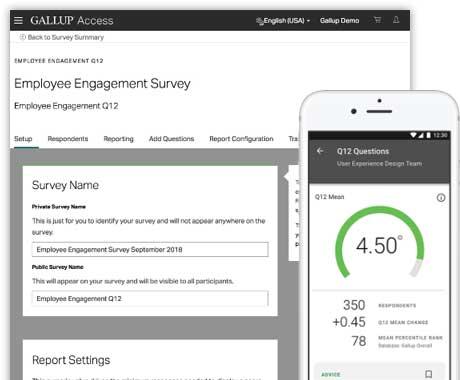Story Highlights
- Regain solid footing for your organization with clear communication
- Frequent communication keeps team managers on the same page
- Discover this essential checklist to uncover barriers and provide vital insights
Do your employees know the plan?
Leaders who effectively communicate a direction and a clear plan provide stability for their employees (stability is one of the four needs of followers).
But Gallup research shows that 22% of employees strongly agree the leaders in their organization have a clear direction for the organization -- and that was before the COVID-19 outbreak.
Now, and especially if communication was already lacking in your organization, it stands to reason that you might not be providing as much stability as employees need during this time when feelings of isolation are prevalent and shelter-in-place orders vary from state to state.
To create stability, leaders need to share their plans to get the organization on solid footing and how those plans affect employees personally.
And leaders need to think about their communication frequency and tone, accounting for engagement, and ensuring they're actively listening and receiving timely feedback.
Consider the Characteristics of Your Frequency and Tone
Employees start to create their own reality when they're worried and they don't know what leadership is thinking or doing. This can jump-start the spread of rumors throughout your workplace.
Leaders can halt that reaction with frequent, perhaps daily, communication, leveraging multiple communication touchpoints, and ensuring their fellow leaders and team managers are on the same page.
Gallup research shows that 22% of employees strongly agree the leaders in their organization have a clear direction for the organization -- and that was before the COVID-19 outbreak.
Still, what leaders communicate is as important as how often they communicate.
A leader's actions and words are analyzed closely by their people. The need for stability is an emotional as well as rational response, so leaders must balance candor with hope for the future in their messaging. Employees deserve honesty and shouldn't be sheltered from the truth. In the absence of communication, unnecessary fear is driven by uncertainty and can sap their motivation.
People need to know their jobs are safe -- if indeed they are -- but they also crave knowledge about the organization's future: where it's heading, how it's holding up financially, how client work is affected, the short-term plans to get through tough times, and how every individual can contribute to help the organization survive and ideally thrive post-pandemic.
These are all messages that need proactive reinforcement on a continuous basis delivered with a realistic, candid, honest tone.
Why It's Important to Account for Engagement
Leaning into the critical aspects of employee engagement can help leaders communicate to establish stability more effectively -- and may inspire more positivity as well.
People need to know their jobs are safe -- if indeed they are -- but they also crave knowledge about the organization's future.
Even though the majority of U.S. employees report working from home as of late April, they still have critical workplace needs that must be met if they are to perform at a high level, needs that are captured in Gallup's Q12 employee engagement survey.
Specifically, leaders need to continually address two of those needs during this time of change -- role expectations and mission and purpose.
Role Expectations
Q1 Topic: I know what is expected of me at work.
For employees to perform well in a role, they need to understand the tasks required of their role and what success looks like, the expectations of the working environment, and the collective expectation the team has of one another. For some workers, a remote setting fundamentally alters their task execution, ability to collaborate and means of personal connection.
Organizational and team leaders need to communicate and reinforce necessary adjustments to roles. That may mean a new definition of acceptable work arrangements and hours, a new view of the integration of work-life and family life, different client fulfillment and delivery, even new opportunities to reorient individual and team contributions to support the business.
Employees need candid and clear feedback on what's expected of them in this new environment, and team leaders need to constantly reinforce priorities.
Mission and Purpose
Q8 Topic: The mission or purpose of my organization makes me feel my job is important.
Organizations with a strong mission and purpose have an advantage during times of change. Individuals who believe their work is meaningful can also experience positive psychological and wellbeing benefits. So reinforcing mission and purpose, and helping people see how they specifically contribute to the fulfillment of that mission, can be a stabilizing force and create a sense of hope for employees.
Hope can create resilience to help organizations get through the unique challenges they're facing.
Communicating clearly and honestly about expectations, but also reinforcing their link to the mission with a hopeful tone will create added clarity and stability that employees need.
How Listening to the Answers to Five Key Questions Improves Communication
Communicating effectively requires listening effectively: Leaders should ask for and reflect on feedback from employees -- and acting on that feedback shows people that leaders genuinely care about them.
Gallup has leveraged past research to develop a short set of questions leaders can use to "listen" more effectively during the coronavirus outbreak. The questions help leaders gauge employee reactions and optimize their strategic decisions for their organizations. They are:
- Does my leadership have a clear plan of action?
- Do I feel well-prepared to do my job?
- Does my supervisor keep me informed about what is going on?
- Does my organization care about my wellbeing?
- Over the past 24 hours, how often have I been practicing social distancing?
Asking employees to answer these gives leaders a timely performance indicator of the efficacy of their communication efforts.
These five questions should also be a checklist for leaders in one-on-one and team conversations -- it will help them uncover barriers and provide insights for action on these important topics. In fact, Gallup consultants are supporting our clients by implementing these items through the Gallup Access platform to field surveys and guiding clients on subsequent actions.
Do that, and leaders will create stability for their organization. Employees have always needed that sense of security and certainty, hope and reassurance, but never more so than now.
Explore more resources for communicating and leading through disruption:
- Stay up to date with Gallup's COVID-19 analytics and advice.
- Partner with Gallup to get more analytics and advice on managing performance during a crisis.
- Read a compilation of our research and advice on employee engagement.





